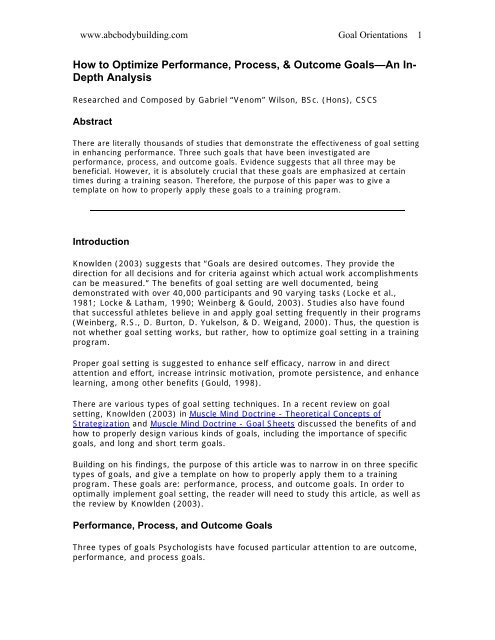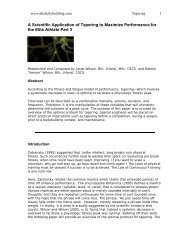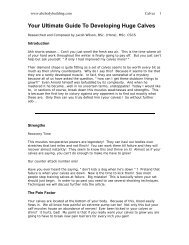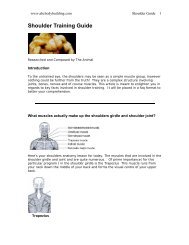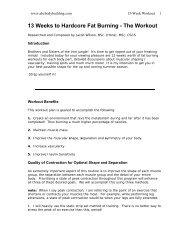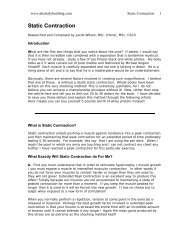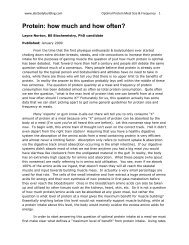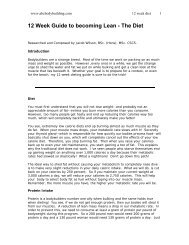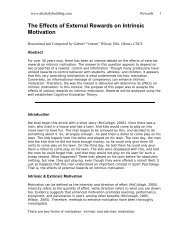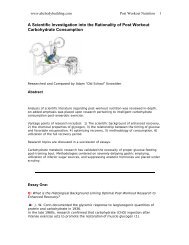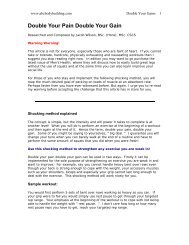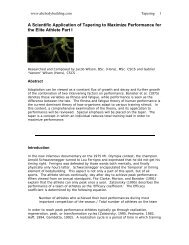How to Optimize Performance, Process, & Outcome Goals—An In ...
How to Optimize Performance, Process, & Outcome Goals—An In ...
How to Optimize Performance, Process, & Outcome Goals—An In ...
Create successful ePaper yourself
Turn your PDF publications into a flip-book with our unique Google optimized e-Paper software.
www.abcbodybuilding.com Goal Orientations 1<br />
<strong>How</strong> <strong>to</strong> <strong>Optimize</strong> <strong>Performance</strong>, <strong>Process</strong>, & <strong>Outcome</strong> <strong>Goals—An</strong> <strong>In</strong>-<br />
Depth Analysis<br />
Researched and Composed by Gabriel “Venom” Wilson, BSc. (Hons), CSCS<br />
Abstract<br />
There are literally thousands of studies that demonstrate the effectiveness of goal setting<br />
in enhancing performance. Three such goals that have been investigated are<br />
performance, process, and outcome goals. Evidence suggests that all three may be<br />
beneficial. <strong>How</strong>ever, it is absolutely crucial that these goals are emphasized at certain<br />
times during a training season. Therefore, the purpose of this paper was <strong>to</strong> give a<br />
template on how <strong>to</strong> properly apply these goals <strong>to</strong> a training program.<br />
<strong>In</strong>troduction<br />
Knowlden (2003) suggests that “Goals are desired outcomes. They provide the<br />
direction for all decisions and for criteria against which actual work accomplishments<br />
can be measured.” The benefits of goal setting are well documented, being<br />
demonstrated with over 40,000 participants and 90 varying tasks (Locke et al.,<br />
1981; Locke & Latham, 1990; Weinberg & Gould, 2003). Studies also have found<br />
that successful athletes believe in and apply goal setting frequently in their programs<br />
(Weinberg, R.S., D. Bur<strong>to</strong>n, D. Yukelson, & D. Weigand, 2000). Thus, the question is<br />
not whether goal setting works, but rather, how <strong>to</strong> optimize goal setting in a training<br />
program.<br />
Proper goal setting is suggested <strong>to</strong> enhance self efficacy, narrow in and direct<br />
attention and effort, increase intrinsic motivation, promote persistence, and enhance<br />
learning, among other benefits (Gould, 1998).<br />
There are various types of goal setting techniques. <strong>In</strong> a recent review on goal<br />
setting, Knowlden (2003) in Muscle Mind Doctrine - Theoretical Concepts of<br />
Strategization and Muscle Mind Doctrine - Goal Sheets discussed the benefits of and<br />
how <strong>to</strong> properly design various kinds of goals, including the importance of specific<br />
goals, and long and short term goals.<br />
Building on his findings, the purpose of this article was <strong>to</strong> narrow in on three specific<br />
types of goals, and give a template on how <strong>to</strong> properly apply them <strong>to</strong> a training<br />
program. These goals are: performance, process, and outcome goals. <strong>In</strong> order <strong>to</strong><br />
optimally implement goal setting, the reader will need <strong>to</strong> study this article, as well as<br />
the review by Knowlden (2003).<br />
<strong>Performance</strong>, <strong>Process</strong>, and <strong>Outcome</strong> Goals<br />
Three types of goals Psychologists have focused particular attention <strong>to</strong> are outcome,<br />
performance, and process goals.
www.abcbodybuilding.com Goal Orientations 2<br />
<strong>Outcome</strong> goals, also known as competitive or ego goals, focus on comparing yourself<br />
<strong>to</strong> others, and defeating them. For example, focusing on out performing someone in<br />
an event, or winning a bodybuilding competition. These types of goals are in large<br />
part out of the control of the individual, because athletes can not control how their<br />
competition prepares for an event. For instance, the competition in a bodybuilding<br />
contest may be well above expectations; and though an athlete showed up in the<br />
best shape of their life, if they lose, they would still be disappointed, because they<br />
lost.<br />
<strong>Performance</strong> goals, also known as mastery goals, focus on your overall performance<br />
(self comparison). For example, improving your 1 repetition maximum (1RM) on<br />
squats by 20 pounds, or losing 2 inches off your waist. Unlike outcome goals, these<br />
types of goals do not involve comparison of yourself with others, and therefore, are<br />
in your control.<br />
<strong>Process</strong> goals focus on improving form, strategy, and other processes an individual<br />
must go through during a task <strong>to</strong> perform a skill successfully. For example, focusing<br />
on keeping your back erect during dead lifts, or recording your diet on a daily bases,<br />
and following certain guidelines such as eating 2 tablespoons of essential fatty acids<br />
per day.<br />
A large amount of research has focused on the benefits of a mastery (or<br />
performance) rather than an outcome oriented mentality. The next section will<br />
discuss this <strong>to</strong>pic in-depth.<br />
Mastery vs. <strong>Outcome</strong> Oriented Goals<br />
Motivation can be defined as the intensity and direction of effort (McCullagh, 2005).<br />
<strong>In</strong>tensity refers <strong>to</strong> the quantity of effort, while direction refers <strong>to</strong> what you are drawn<br />
<strong>to</strong>o. Evidence suggests that enhanced motivation promotes learning, performance,<br />
enjoyment, and persistence in sport, among other benefits (McCullagh, 2005;<br />
Wilson, 2005; Fry & Fry, 1999). Therefore, methods <strong>to</strong> enhance motivation have<br />
been thoroughly investigated.<br />
Nicholls (1989), a renowned educational psychologist, dedicated years of his life <strong>to</strong><br />
developing a model <strong>to</strong> predict motivation. Models are vital <strong>to</strong> research because they<br />
offer a framework for many areas of research aimed at the nature of the <strong>to</strong>pic,<br />
addresses possible mechanisms, and suggest several specific interventions<br />
(McCullagh, 2005). Nicholls Achievement Motivation Theory suggests that two types<br />
of goals—outcome and mastery goals—determine how an individual determines their<br />
success in an achievement situation. <strong>In</strong> review, a mastery goal orientation has <strong>to</strong> do<br />
with self comparison and looking at how you improve (performance goals). Whereas,<br />
outcome goals, also known as competitive or ego goals, focus on comparing yourself<br />
<strong>to</strong> others, and defeating them. Thus, an individual who is mastery oriented defines<br />
success by mastering skills, effort, and improvement over time. While an individual<br />
who is outcome oriented defines success by normative terms, meaning, when they<br />
out perform their competi<strong>to</strong>rs; they are also less concerned with improvement and<br />
effort.<br />
Nicholls hypothesized that a mastery orientation would promote persistent, effort,<br />
enhance performance and enjoyment, and individuals would seek out more<br />
challenges, all of which would enhance motivation. While outcome orientations,
www.abcbodybuilding.com Goal Orientations 3<br />
particularly when the individual has a low capacity for their activity, would decrease<br />
persistence, effort, performance, enjoyment, and individuals would avoid challenges,<br />
all of which would decrease motivation.<br />
It is important <strong>to</strong> understand that goal orientations are just one fac<strong>to</strong>r which<br />
determines performance. Therefore, Nicholls suggested that no matter the ability of<br />
the individual (be it high or low), they would maximize their potential by adopting a<br />
mastery oriented perspective.<br />
Nicholls theory has been investigated thoroughly, and is well supported by the<br />
research (McCullagh, 2005; Weinberg & Gould, 2003).<br />
Fry and Fry (1999) used the Theory of Achievement Motivation <strong>to</strong> examine the goal<br />
perspectives and motivational responses of 171 (48 females and 123 males) elite<br />
junior weight lifting athletes. Participants were asked <strong>to</strong> fill out a survey while<br />
competing in the 1995 National Junior Weightlifting Championships and the 1996<br />
Junior Olympics. The survey analyzed several variables including: goal orientations,<br />
enjoyment, effort, perceived ability, and physical self-worth. Results on gender<br />
differences found that females had significantly higher task orientations than males;<br />
they correspondingly tended <strong>to</strong> have greater enjoyment than males. Correlation data<br />
between the predic<strong>to</strong>r variables (goal orientation) and criterion variables (enjoyment,<br />
effort, perceived ability, and physical self-worth) found that a mastery goal<br />
orientation was positively and significantly correlated <strong>to</strong> the athletes’ perception of<br />
enjoyment and effort. Conversely, a high outcome orientation coupled with a low<br />
mastery orientation was significantly correlated with low effort, less physical selfworth,<br />
and interestingly enough, a high perception of ability. The fact that those high<br />
in outcome orientations tended <strong>to</strong> have a high perception of their ability further<br />
supports Nicholls theory. Nicholls predicted that people that have a high ego<br />
orientation, but a low perceived ability would quit, because their success is<br />
determined by their ability <strong>to</strong> defeat others. It is suggested that these individuals<br />
must convince themselves that they have a high ability, in order <strong>to</strong> persevere in<br />
sport. <strong>How</strong>ever, individuals who are mastery oriented have a more accurate<br />
perception of their ability, because ability is not as critical a fac<strong>to</strong>r for them. Thus, no<br />
matter what their perceived ability, they will still give high effort, seek challenges,<br />
and persevere. Therefore, collectively, these results supported Nicholls Achievement<br />
Motivation Theory.<br />
New<strong>to</strong>n and Duda (1993) examined elite young tennis players, and found that<br />
athletes high in outcome orientation believed that the major cause for success in<br />
their sport was being gifted, or knowing how <strong>to</strong> impress the coach. Whereas athletes<br />
high in mastery orientation believed that effort was a vital fac<strong>to</strong>r for success in sport,<br />
and did not believe that external fac<strong>to</strong>rs, such as equipment, or cheating, or being<br />
able <strong>to</strong> deceive the coach, contributed <strong>to</strong> being successful at tennis. It is suggested<br />
that believing effort, rather than natural ability or cheating is the cause for your<br />
success will result in greater sport success, because effort is in the control of the<br />
athlete; further, if they perceive they have a low ability, they may quit. Similar<br />
results were found with elite downhill skiers (Duda and White, 1992)<br />
Other studies also indicate that mastery oriented individuals engage more in problem<br />
solving during stressful events (Pensgaard & Roberts).
www.abcbodybuilding.com Goal Orientations 4<br />
Ommundsen and Roberts (1996) examined over 200 athletes participating in the<br />
Norwegian Sport Association. Results indicated that athletes high in mastery<br />
orientations claimed that they trained <strong>to</strong> enjoy social interactions, and <strong>to</strong> assist them<br />
in maximizing their athletic performance. While outcome oriented athletes also<br />
trained <strong>to</strong> maximize sport achievement, they also trained <strong>to</strong> increase their social<br />
status and gain personal recognition.<br />
Numerous other studies have found that a mastery goal orientation results in<br />
increased effort, intrinsic interest, enjoyment, greater performance, less boredome,<br />
greater persistence, and seeking more challenging activities (Duda, Fox, Biddle, &<br />
Armstrong, 1992; Duda & Nicholls, 1992; Solmon & Boone, 1993). Conversely,<br />
studies indicate that outcome orientations promote numerous adverse behaviors<br />
which decrease motivation, such as declines in concentration; further, this mentality<br />
commonly promotes unsportsmanlike conduct, including purposely harming others,<br />
and cheating (Duda, Olson, and Templin, 1991; New<strong>to</strong>n, & Duda, 1993; White, &<br />
Zellner, 1996). So clearly, having a higher mastery goal orientation is beneficial for<br />
motivation.<br />
The other fac<strong>to</strong>r in Nicholls' theory is the motivational climate, which is established<br />
by the coaches, peers, and adults. A mastery oriented climate occurs when coaches<br />
reward athletes for effort, improving skills, and cooperation. While an outcome<br />
oriented climate occurs when coaches reward winning, and competition. <strong>In</strong> this<br />
context, Ommundsen, Roberts, and Kavussanu (1998) indicated that athletes, who<br />
perceived they were in a mastery motivational climate, had greater enjoyment,<br />
satisfaction, a greater desire <strong>to</strong> learn during practice, and a greater appreciation for<br />
developing skills. While athletes who perceived they were in an outcome motivational<br />
climate, were not as interested in having fun or being satisfied, and believed sport<br />
should facilitate a better social status. Therefore, the motivational climate and<br />
intrinsic goal orientation of the athlete are both vital fac<strong>to</strong>rs <strong>to</strong> consider for<br />
motivation.<br />
Studies in academic settings also support mastery over outcome goal orientations.<br />
Ames (1990) has convincingly shown this in several in-depth investigations on the<br />
effects of goal orientations on academic performance. His findings indicate that a<br />
mastery oriented classroom enhances academic performance in reference <strong>to</strong> an<br />
outcome oriented classroom. So it would benefit teachers <strong>to</strong> pay close attention <strong>to</strong><br />
this article!<br />
Further support for a mastery goal orientation comes from studies on Rewards and<br />
Competition vs. Cooperation.<br />
Therefore, psychologists have been strong advocates of a mastery oriented goal<br />
orientation and motivational climate.<br />
<strong>How</strong>ever, Nicholls suggested that goal orientations are independent, meaning that<br />
one may be high in both mastery and outcome orientations, or low in both<br />
orientations, or high in one orientation, and low in another. Further, he suggested<br />
that athletes exhibit both orientations <strong>to</strong> some extent. <strong>In</strong> this context, it is important<br />
<strong>to</strong> understand the influence of combining both goal orientations.<br />
Hom, Duda, and Miller (1993) examined goal orientations in youth basketball<br />
players. Results indicated that athletes who had both mastery and outcome goal
www.abcbodybuilding.com Goal Orientations 5<br />
orientations had greater levels of enjoyment and competence, than athletes with<br />
only a master or outcome oriented goal. Similarly, Fox, Goudas, Biddle, Duda, and<br />
Armstrong (1994) found that athletes from various sports who had both goal<br />
orientations had greater perceived sport competence, and enjoyment, than athletes<br />
who adopted only mastery or outcome goals. Roberts, Treasure and Kavussanu<br />
(1996) found similar results <strong>to</strong>o these two studies.<br />
Other studies have also found that athletes with both mastery and outcome goal<br />
orientations persist longer in sports, and report the greatest years of sport<br />
participation (Duda, 1988, 1999). Studies also suggest that athletes with both goals<br />
have higher intrinsic motivation (Fox et al., 1994; Hom et al., 1993).<br />
One argument against these studies, is that they are correlative in nature, and<br />
therefore, do not confirm causality. Further, studies have failed <strong>to</strong> examine the<br />
effects of a multiple goal motivational climate.<br />
<strong>In</strong> this context, Steinberg, Singer, Murphey, & Milledge (2000) performed perhaps<br />
the most comprehensive experiment ever on Nicholls (1989) Achievement Motivation<br />
Theory. Participants consisted of 72 college students, enrolled in a beginning golf<br />
class. The motivational climate was a mastery/competitive situation. Participants<br />
were assigned <strong>to</strong> 4 conditions: master/competitive goal, mastery, competitive, and<br />
no goal (control) conditions. Participants practiced golf putting for 18 sessions, over<br />
a 6 week time span on a putting green. Participants in the mastery group were given<br />
the goal <strong>to</strong> improve by 5% each week on a mini golf task, and a target putting task.<br />
Participants in the outcome condition were given the goal <strong>to</strong> win at least 50% of solo<br />
best ball games and 50% of the team best ball games played. Participants in the<br />
mastery/competitive group were given the goal of achieving one mastery goal and<br />
one competitive goal.<br />
Results indicated that participants in the mastery/competitive condition had the<br />
highest persistence during training, in that they trained almost twice as much as the<br />
other participants, had greater intrinsic motivation, as inferred by greater<br />
enjoyment/interest and effort/perceived importance, and performance tended <strong>to</strong><br />
increase <strong>to</strong> a greater extent, probably due <strong>to</strong> greater motivation and practice.<br />
There are several theoretical rationales for these results. Duda (1989) suggests that<br />
"a person who stresses both goal perspectives has two sources of success and<br />
several reasons <strong>to</strong> continue participation in the activity" and that a multiple goal<br />
orientation "provides the participant with mastery standards <strong>to</strong> fall back on if he or<br />
she is not the best at a specific task" (p.103). Thus, having both goal orientations is<br />
suggested <strong>to</strong> increase incentive motivation, and reinforcement opportunities. Swain<br />
and Hardwood (1996) have been so bold <strong>to</strong> suggest that someone with both goal<br />
orientations cannot fail <strong>to</strong> be satisfied!<br />
Roberts (1992) suggests that people that enter in<strong>to</strong> a motivational climate, which<br />
conflicts with their motivational goals may perceive conflict in motivations, leading <strong>to</strong><br />
decreased motivation. For example, if an athlete has an outcome oriented goal, and<br />
the motivational climate is mastery oriented, this may decrease motivation. This was<br />
supported by Steinberg et al. (2000), who found that participants in the mastery<br />
oriented condition actually had decreased intrinsic motivation!
www.abcbodybuilding.com Goal Orientations 6<br />
Thus, multiple goals may allow for motivational coping strategies (i.e. enhanced<br />
adaptability <strong>to</strong> various situations). <strong>In</strong> a real world setting, this has practical<br />
significance, as sports often entail using both goal orientations. For instance, an<br />
athlete may first begin their sporting career by focusing on mastery goals, then<br />
focusing on outcome goals, then going back <strong>to</strong> mastery goals, etc. Therefore,<br />
adaptability is imperative.<br />
Steinberg et al. (2000) suggest that the issue may not be mastery vs. outcome goal<br />
orientations at all. But instead, when <strong>to</strong> emphasize such orientations, as evidence<br />
suggests both can be important at certain times. Optimal times <strong>to</strong> implement goal<br />
orientations will be discussed further on.<br />
Steinberg et al. concluded that (the notes in brackets are mine), “Perhaps, the<br />
optimal achievement strategy would be one that not only focuses on opportunities<br />
for growth and development [mastery goals], but also allows for recognition of a<br />
normative basis [outcome goals]. Such a strategy should make an individual better<br />
equipped <strong>to</strong> cope with the task at hand, and therefore, provide the best possibility<br />
for attaining athletic excellence.”<br />
Therefore, the current author suggests that the athlete should focus on a mastery<br />
goal orientation, and coaches should foster a mastery oriented motivational climate.<br />
<strong>How</strong>ever, we should not be dogmatic with these practices, and ignore outcome goals.<br />
We should acknowledge outcome goals and reinforce them when they are done. For<br />
example, athletes/coaches should acknowledge and celebrate vic<strong>to</strong>ries. Or in an<br />
academic setting, students/teachers should acknowledge and celebrate high grades.<br />
This should optimize incentive motivation, persistence, reinforcement opportunities,<br />
intrinsic motivation, and performance. More practical applications will be discussed<br />
further in the article.<br />
Next, the benefit of process goals, particularly when compared <strong>to</strong> other goal setting<br />
strategies, will be discussed.<br />
<strong>Process</strong> vs. <strong>Performance</strong> Goals<br />
<strong>In</strong> review, process goals focus on improving form, strategy, and other processes an<br />
individual must go through during a task <strong>to</strong> perform a skill successfully. For example,<br />
focusing on keeping your back erect during dead lifts, or recording your diet on a<br />
daily bases, and following certain guidelines such as eating 2 tablespoons of essential<br />
fatty acids per day.<br />
But before moving on, we need <strong>to</strong> discuss a concept called imagery. Imagery can be<br />
defined as creating or recreating images in the mind. Imagery involves all the senses<br />
including visual, kinesthetic, audi<strong>to</strong>ry, and olfac<strong>to</strong>ry senses. It also involves moods<br />
and emotions (Simons, 2005). Sport Psychologists are strong advocates of the use of<br />
imagery for athletes. For instance, Weinberg and Gould (2003) state that, “evidence<br />
from scientific experiments in support of imagery is impressive and clearly<br />
demonstrates the value of imagery in learning and performing skills.” There are<br />
various techniques for applying imagery, and these techniques can have differing<br />
effects on performance.
www.abcbodybuilding.com Goal Orientations 7<br />
<strong>In</strong> this context, Singer, Bouchard and Pena (2001) compared the effects of a process<br />
orientation (imaging planning, organizing, and preparing) versus a performance goal<br />
orientation ('imaging doing well on tests,) on tennis skills and written tests.<br />
Participants consisted of 76 university students. Participants in the process<br />
orientation condition imagined steps which would allow them <strong>to</strong> be successful on the<br />
written exam and skills test. For example, for the skills test they imagined practicing<br />
sufficiently, with a commitment <strong>to</strong> improve, and planned the time of day they would<br />
practice. And for the written test, they imagined studying efficiently and successfully,<br />
with complete focus in a quiet place. Participants in the performance condition<br />
imagined the joy of doing well on the exams. For example, imaging the feeling of<br />
being happy after a perfect stroke. Results found that participants in the process<br />
condition outperformed the performance condition in the skill test. While all<br />
conditions improved on the writing test, there was no significant difference between<br />
conditions. The authors suggested that the reason participants did not differ in tennis<br />
scores on the written exam, may have been that the written tennis exam was not<br />
perceived as important, and also, it was not performed in front of their pears.<br />
This is in agreement with the findings of Taylor Pham, Rivkin, and Armor (1998) who<br />
found that using process goal imagery facilitated performance for a psychology<br />
exam.<br />
Singer, Bouchard and Pena (2001) also found that participants in the process goal<br />
imagery condition spent more time out of the class room preparing for their test,<br />
which is in agreement with other studies (Martin & Hall, 1995; Pham & Taylor.<br />
1999). It is suggested that process goals may enhance intrinsic motivation for<br />
participants <strong>to</strong> perform their activity; and also save them time through mental<br />
preparation.<br />
<strong>In</strong> a revolutionary experiment on this <strong>to</strong>pic, Kings<strong>to</strong>n and Hardy (1997) examined<br />
the effects of performance and process goals on various criterion variables during a<br />
golfing season. Participants consisted of 37 experienced golfers. The experimenters<br />
performed a longitudinal study over 54 weeks of a competitive golf season. They<br />
<strong>to</strong>ok data during week 1 (baseline) (test 1), week 23 (test 2), and week 54 (test 3).<br />
They measured performance based on their scores; state anxiety and self confidence<br />
were measured with the Competitive State Anxiety <strong>In</strong>ven<strong>to</strong>ry (CSAI-2)<br />
questionnaire, which has been demonstrated <strong>to</strong> be both reliable and valid<br />
(McCullagh, 2005); lastly, the Sports-Related Psychological Skills Questionnaire<br />
(SPSQ), which has also been demonstrated <strong>to</strong> be valid and reliable (Nelson and<br />
Hardy, 1990), was used <strong>to</strong> measure self efficacy (a task-specific self confidence),<br />
cognitive anxiety control skills (the capacity <strong>to</strong> control anxiety), and concentration<br />
skills.
www.abcbodybuilding.com Goal Orientations 8<br />
Figure 1.<br />
The Effects of <strong>Process</strong> Goals on Various Criterion Variables of Golfing Skills<br />
Figure 2.<br />
The Effects of <strong>Performance</strong> Goals on Various Criterion Variables of Golfing Skills<br />
Note: A lower score indicates a greater capacity and skills for the following<br />
measurements: performance, cognitive anxiety (mental anxiety), and somatic
www.abcbodybuilding.com Goal Orientations 9<br />
anxiety (bodily anxiety). A higher score indicates a greater capacity and skills for the<br />
following measurements: self confidence, self efficacy, cognitive anxiety control<br />
skills, and concentration skills.<br />
Figure 1 and 2 graphically depicts the results of this experiment. The results<br />
indicated that the process goal condition significantly improved in performance based<br />
on their scores from test 1 <strong>to</strong> 2; while the performance goal condition did not<br />
improve from test 1 <strong>to</strong> 2, but did significantly improve between test 1 and 3.<br />
Therefore, process goals may facilitate learning at a significantly faster rate than<br />
performance goals.<br />
Based on the CSAI-2 measurement, results indicated that both goal setting<br />
conditions had significantly lower anxiety and higher self confidence than the control<br />
condition. Further, process goals had a trend <strong>to</strong> produce lower anxiety and greater<br />
self confidence than performance goals.<br />
The SPSQ revealed that process goal condition significantly improved self efficacy,<br />
cognitive anxiety control skills, and concentration skills. While neither the control or<br />
performance goal conditions significantly altered any of these variables.<br />
This is consistent with earlier studies that indicate that process goals reduce anxiety<br />
and facilitate performance during otherwise stressful competitive situations<br />
(Kings<strong>to</strong>n, Hardy, & Markland, 1992).<br />
The reason performance goals are not as effective at reducing anxiety, and may<br />
actually increase anxiety, can be better unders<strong>to</strong>od better when analyzing what<br />
actually generates anxiety. Locke and Latham (1985) suggest that things that can<br />
generate anxiety are: task importance, action requirement, and something that may<br />
not always be achieved (uncertainty). Consequently, performance goals contain all of<br />
these properties.<br />
<strong>Process</strong> goals also allow the administra<strong>to</strong>r <strong>to</strong> breakdown complex goals in<strong>to</strong> discrete<br />
behaviors (processes) which can make the transition much smoother and faster. For<br />
example, if you are going on a strict diet, focusing on process goals and recording<br />
your diet can be very helpful. For instance, recording that you need: 6 meals a day,<br />
3 low carb meals, certain vitamins and minerals, etc. This will be discussed more<br />
further on.<br />
Concerning process goals ability <strong>to</strong> enhance concentration, it has been suggested<br />
that process goals facilitate the allocation of attentional resources <strong>to</strong> the task at end,<br />
and decrease focus on superfluous thoughts, such as what you are going <strong>to</strong> do later<br />
in the day, increasing concentration. For instance, instead of focusing on getting 10<br />
reps on a squat (performance goal) focusing on the process (i.e. just squatting<br />
smoothly during each rep, and leaving all other thoughts out of your mind) will<br />
narrow your attention <strong>to</strong> the activity <strong>to</strong> a greater extent.<br />
Another fac<strong>to</strong>r is that process goals enhance your control. As stated, outcome goals<br />
are commonly outside of your control, because you cannot control how your<br />
competi<strong>to</strong>rs train. Further, performance goals are not always entirely in your control<br />
(though much more so than outcome goals). External fac<strong>to</strong>rs such as your partner<br />
can also influence this. <strong>How</strong>ever, process goals are almost entirely in your control, as<br />
they are <strong>to</strong>tally focused on what it takes <strong>to</strong> pursuit a performance goal.
www.abcbodybuilding.com Goal Orientations 10<br />
As process goals can be achieved very consistently, this is the reason why process<br />
goals are suggested <strong>to</strong> increase self efficacy (as demonstrated in the aforementioned<br />
experiment).<br />
All of these fac<strong>to</strong>rs would lead <strong>to</strong> enhanced performance, which again was<br />
demonstrated in the above experiment.<br />
One potential problem with process goals has been proposed by Baumeister (1984)<br />
and Masters (1992). Evidence suggests that when learning a skill, the participant<br />
goes through a phase called cognitive verbal, in which their performing of the skill is<br />
slow and requires a great deal of cognitive attention. <strong>How</strong>ever, well learned skills<br />
become 'au<strong>to</strong>matic' and require little cognitive effort or attention. <strong>In</strong> this context, it<br />
has been suggested that process goals, that increase cognitive effort on the skills<br />
being performed, may cause the participant <strong>to</strong> relapse <strong>to</strong> conscious control of skills,<br />
which is slow and not optimal for performance. For more information on this, refer <strong>to</strong><br />
the following articles on the Specificity Hypothesis.<br />
Several solutions have been proposed for this problem, based on the learning<br />
process.<br />
For beginners, focusing on key parts of the movement should facilitate learning of<br />
skills, and future au<strong>to</strong>nomousy. <strong>How</strong>ever, for advanced athletes, they should set<br />
holistic process goals, which means goals based on the entire movement, rather than<br />
breaking it up in<strong>to</strong> parts. For instance, someone squatting should not focus on<br />
keeping their back straight, going down in 3 seconds, up in 2 seconds, and looking<br />
up, etc. <strong>In</strong>stead, just focus on one holistic term such as being smooth on your lifts.<br />
For other sports such as hockey, many of the skills such as skating are au<strong>to</strong>matic; by<br />
focusing on the process, the player can focus their attention on the many cues in the<br />
environment, such as opposing players.<br />
A good example of how <strong>to</strong> use process goals as you proceed along the learning curve<br />
is demonstrated in the following quote by a very successful pis<strong>to</strong>l shooter:<br />
I would write what I wanted <strong>to</strong> do and say <strong>to</strong> myself, ‘What am I going <strong>to</strong> do<br />
this training session?’ I wouldn’t just get on the line and pump rounds down<br />
the range, but would actually go <strong>to</strong> the line with an intent, a goal, even if it<br />
was just <strong>to</strong> make sure everything was smooth. When I go <strong>to</strong> the line, and set<br />
everything up, and take up the gun in my hand, I also mentally go through<br />
my shot plan checklist before I shoot. This strategy started out very<br />
mechanically, with a physical list of words which I have on the shooting table<br />
and which I read exactly. These words represented every single step involved<br />
in shooting a shot. Then, I reduced these <strong>to</strong> key words so that I could go<br />
through the list faster. Finally, I didn’t need the list anymore. I would usually<br />
write on word <strong>to</strong> emphasize what I wanted such as, ‘trigger’ or ‘smooth’. Then<br />
this shot-plan rehearsal became a mix of simple verbal reminders and images<br />
which I ran before each shot (Orlick & Parting<strong>to</strong>n, 1988, pp. 111-112).<br />
As you see, at first, he was very mechanical and slow, and it <strong>to</strong>ok a great deal of<br />
cognitive effort for him <strong>to</strong> shoot. <strong>How</strong>ever, as he progressed, he became much more<br />
efficient, faster, and ‘au<strong>to</strong>matic.’ Therefore, he only used one process term such as<br />
‘trigger’ or ‘smooth’ just <strong>to</strong> get him <strong>to</strong> focus on the movement as a whole (not parts).
www.abcbodybuilding.com Goal Orientations 11<br />
The main point is that your attention should be focused on the task at hand. Any<br />
other thought, such as saying you have <strong>to</strong> achieve 10 reps (a performance goal) will<br />
decrease your concentration of the task at end, and potentially elicit other adverse<br />
effects.<br />
<strong>Process</strong>, <strong>Performance</strong>, & <strong>Outcome</strong> Goals—tying them <strong>to</strong>gether<br />
So what is best—performance, process, or outcome goals?<br />
To answer this question, Filby, Maynard, and Graydon (1999) investigated the effects<br />
of a combination of outcome, performance, and process goals, or using each goal<br />
separately, on performance. Participants consisted of 40 soccer players, who were<br />
tested on a soccer task. <strong>Performance</strong> was measured over 5 weeks, and then in a<br />
competition. Results found that multiple goal setting strategies (outcome,<br />
performance, and process goals) resulted in significantly greater performance than<br />
using one type of goal.<br />
Therefore, the question asked at the introduction of this section is not something<br />
that can really be answered. Rather, what we need <strong>to</strong> focus on is the degree <strong>to</strong><br />
which we prioritize process, performance, and outcome goals in various situations, as<br />
evidence clearly suggests all three can be beneficial.<br />
Filby, Maynard, and Graydon (1999) suggest that:<br />
The benefits of adopting an outcome goal are realized only when the outcome<br />
goal is combined with the prioritization of a process orientation immediately<br />
before and during performance (p. 242).<br />
Similarly, Kings<strong>to</strong>n and Hardy (1997) suggest that:<br />
Kings<strong>to</strong>n and Hardy (1994) have highlighted how golfers may use different<br />
types of goals within the framework of preparation and execution of skills. For<br />
example, a golfer might set an outcome goal of winning a <strong>to</strong>urnament in<br />
order <strong>to</strong> motivate himself or herself <strong>to</strong> go out and practice. He or she might<br />
set a series of performance goals <strong>to</strong> increase the salience of practice. Finally,<br />
he or she might use process-oriented goals <strong>to</strong> aid concentration and the<br />
allocation of attentional resources during both practice and competition. What<br />
is important is the degree <strong>to</strong> which we prioritize the goals within different<br />
situational contexts (Kings<strong>to</strong>n & Hardy, 1994). <strong>In</strong> short, outcome and<br />
performance goals might be very important <strong>to</strong> get one <strong>to</strong> the practice ground,<br />
but process goals might be much more important <strong>to</strong> ensure that one uses the<br />
time spent at the practice ground <strong>to</strong> best effect.<br />
Based on the evidence, the current author therefore suggests the following:<br />
• <strong>Performance</strong> and outcome goals should be set prior <strong>to</strong> events. For example,<br />
before actually working out or competing.<br />
• An emphasis should be placed on performance goals, as results clearly<br />
demonstrate that they result in greater performance, among many other<br />
important variables, when compared <strong>to</strong> outcome goals. <strong>How</strong>ever, evidence<br />
suggests that having two goals—performance and outcome goals—results in
www.abcbodybuilding.com Goal Orientations 12<br />
greater performance, and increases in other measurements such as intrinsic<br />
motivation than having one goal orientation. Therefore, the current author<br />
suggests that the athlete should focus on a mastery goal orientation, and<br />
coaches should foster a mastery oriented motivational climate. <strong>How</strong>ever, we<br />
should not be dogmatic with these practices, and ignore outcome goals. We<br />
should acknowledge outcome goals and reinforce them when they are done.<br />
For example, athletes/coaches should acknowledge and celebrate vic<strong>to</strong>ries. Or<br />
in an academic setting, students/teachers should acknowledge and celebrate<br />
high grades. This should optimize incentive motivation, persistence,<br />
reinforcement opportunities, intrinsic motivation, and performance.<br />
• When working out, practicing, or competing, the athlete should focus on<br />
process goals. This will effectively allocate attention <strong>to</strong>wards the task,<br />
decrease various measures of anxiety, and enhance performance. So instead<br />
of focusing on defeating someone on squats, or getting 10 reps on squats—<br />
both of which can enhance anxiety—the athlete should just focus on the<br />
actual process of squatting when they are squatting. This can be applied <strong>to</strong><br />
any exercise. The point is, during actual physical activities, you should focus<br />
your attention on the process of the movement.<br />
• <strong>Process</strong> goals can also be highly beneficial before competitions. You can set<br />
process goals for diet, training consistency, among other areas of interest.<br />
This will be discussed more in practical applications.<br />
<strong>In</strong> conclusion, outcome and performance goals should be emphasized before and<br />
after exercise, with a greater emphasize on performance goals; while process goals<br />
should be emphasized during exercise and before and after exercise.<br />
Conclusion<br />
The results clearly indicate the performance, process, and outcome goals can greatly<br />
impact performance. For practical applications, Click Here.<br />
Keep it Hardcore,<br />
Venom<br />
Vice President of ABCbodybuilding.com<br />
Venom@abcbodybuilding.com<br />
References<br />
Ames, C. (1990, April). Achievement goals and classroom structure: Developing a<br />
learning orientation in students. Paper presented <strong>to</strong> the annual meeting of the<br />
American Educational Research Association, Bos<strong>to</strong>n.<br />
Baumeister, R.F. (1984). Choking under pressure. Self consciousness and<br />
paradoxical effects of incentives on skillful performance. Journal of Personality and<br />
Social Psychology, 46, 610-620.<br />
Duda, J.L., K.R. Fox, S.J.H. Biddle, and N. Armstrong. (1992)Children's achievement<br />
goals and beliefs about success in sport. Br. J. Educ. Psychol. 62:313–323. 1992.
www.abcbodybuilding.com Goal Orientations 13<br />
Duda, J.L., and J.G. Nicholls. (1992). Dimensions of achievement motivation in<br />
schoolwork and sport. J. Educ. Psychol. 84:290–299.<br />
Duda, J.L., L.K. Olson, and T.J. Templin. (1996). The relationship of task and ego<br />
orientation <strong>to</strong> sportsmanship attitudes and the perceived legitimacy of injurious acts.<br />
Res. Q. Exerc. Sport. 62:79–87.<br />
Duda, J.L., and S.A. White. (1992). Goal orientations and beliefs about the causes of<br />
sport success among elite skiers. Sport Psychol. 6:334–343.<br />
Duda, J. L. (1988). The relationship between goal perspectives, persistence and<br />
behavioral intensity among male and female recreational sport participants. Leisure<br />
Sciences, 10,95-106.<br />
Duda, J. L. (1989). Goal perspectives, participation, and persistence in sport.<br />
<strong>In</strong>ternational Journal of Sport Psychology 20, 42-5 6.<br />
Filby, W.C.D., I.W. Maynard, and J.K. Graydon. The effect of multiple-goal strategies<br />
on performance outcomes in training and competition. J. Appl. Sport Psychol.<br />
11:230–246. 1999.<br />
Fox, K., Goudas, M., Biddle, S., Duda. J., & Armstrong, N. (1994). Children's task<br />
and ego goal profiles in sport. British Journal of Educational Psychology, 64, 253-<br />
261.<br />
FRY MARY D. and ANDREW C. FRY. (1999). Goal Perspectives and Motivational<br />
Responses of Elite Junior Weightlifters. The Journal of Strength and Conditioning<br />
Research: Vol. 13, No. 4, pp. 311–317.<br />
Gould, D. (1998). Goal setting for peak performance. <strong>In</strong> J.M. Williams (Ed.), Applied<br />
sport psychology: Personal growth <strong>to</strong> peak performance (3rd ed., pp. 182-196).<br />
Mountain View CA: Mayfield.<br />
Hom, H. L., Duda, J. L., & Miller, A. (1993). Correlates of goal orientations among<br />
young athletes. Pediatric Exercise Science, 5, 168-176.<br />
Kings<strong>to</strong>n, K.M., and L. Hardy. (1994). Fac<strong>to</strong>rs affecting the salience of outcome,<br />
performance and process goals in golf. <strong>In</strong> A. Cochran & M. Farally (Eds.), Science<br />
and golf 2 (pp. 144-149). London: Chapman-Hill.<br />
Kings<strong>to</strong>n, K.M., and L. Hardy. (1997) Effects of different types of goals on processes<br />
that support performance. Sport Psychol. 11:277–293.<br />
Kings<strong>to</strong>n, K.M., L. Hardy., and Markland, D. (1992). Study <strong>to</strong> compare the effect of<br />
two different goal orientations and stress levels on a number of situationally relevant<br />
performance subcomponents. Journal of Sport Sciences. 10, 610-611.<br />
Locke, EA. & Latham, G.P. (1985). The application of goal setting <strong>to</strong> sports. Journal<br />
of Sport Psychology, 16, 212-215.
www.abcbodybuilding.com Goal Orientations 14<br />
Locke, EA. & Latham, G.P. (1990). A theory of goal setting and task performance.<br />
Englewood Cliffs, NJ: Prentice Hall.<br />
Locke et al. (1981). Goal setting and task performance: 1969-1980. Psychological<br />
Bulletin, 90, 125-152.<br />
Masters, R.S.W. (1992). Knowledge, nerves, and know-how. British Journal of<br />
Psychology. 83, 343-358.<br />
Martin, K. A., & Hall, C. R. (1995). Using mental imagery <strong>to</strong> enhance intrinsic<br />
motivation. Journal of Sport & Exercise Psychology 17, 54-69.<br />
McCullagh, Penny. (2005) Sport and Exercise Psychology Lecture. Cal State<br />
University East Bay.<br />
Nelson, D., & Hard. L. (1990). The development of an empirically validated <strong>to</strong>ol for<br />
measuring psychological skill in sport. Journal of Sport Sciences, 8, 71.<br />
New<strong>to</strong>n, M.L., and J.L. Duda. (1993). Relationship of task and ego orientation <strong>to</strong><br />
performance-cognitive content, affect, and attributions in bowling. J. Sport Behav.<br />
16:209–220.<br />
New<strong>to</strong>n, M.L., and J.L. Duda. (1993). Elite adolescent athletes' achievement goals<br />
and beliefs concerning success in tennis. J. Sport Exerc. Psychol. 15:322–341.<br />
Nicholls, J.G. (1989). The Competitive Ethos and Democratic Education. Cambridge,<br />
MA: Harvard University Press.<br />
Ommundsen, Y., and G.C. Roberts. (1996) Goal orientations and perceived purposes<br />
of training among elite athletes. Percept. Mot. Skills. 83:463–471.<br />
Ommundsen, Y., G.C. Roberts, and M. Kavussanu. (1998). Perceived motivational<br />
climate and cognitive and affective correlates among Norwegian athletes. J. Sports<br />
Sci. 16:153–164.<br />
Orlick & Parting<strong>to</strong>n (1988). Mental links <strong>to</strong> excellence. The Sport Psychologist, 2,<br />
105-131.<br />
Pham, L. B., & Taylor, S. E. (1999). From thought <strong>to</strong> action: Effects of process<br />
versus outcome-based mental simulations on performance. Personality and Social<br />
Psychology Bulletin, 25, 250-260.<br />
Pensgaard, A.M., and G.C. Roberts. Competing at the Olympics: Achievement goal<br />
orientations and coping with stress. IXth European Congress on Sport Psychology<br />
Proceedings: <strong>In</strong>tegrating Labora<strong>to</strong>ry and Field Studies. FEPSAC, Brussels, Part II.<br />
701–708.<br />
Roberts, G.C. (1992). Motivation in sport and exercise: Conceptual constraints and<br />
convergence. <strong>In</strong> G. Roberts (Ed.), Motivation in sport and exercise (pp. 3-31).<br />
Champaign, IL: Human Kinetics.
www.abcbodybuilding.com Goal Orientations 15<br />
Roberts, G.C. & Treasure, D.C. (1992). Children in sport. Sport Science Review,<br />
1,46-64.<br />
Roberts, G.C., Treasure, D.C., & Kavussanu, M. (1996). Orthogonality of<br />
achievement goals and its relationship <strong>to</strong> beliefs about success and satisfaction in<br />
sport. The Sport Psychologist, 10, 398-408.<br />
Simons, Jeff. (2005) Sport and Exercise Psychology Lecture. Cal State University<br />
East<br />
Bay.<br />
Singer, Robert Downs, Danielle Symons Bouchard, Lester Pena, Derek de la. (2001).<br />
The <strong>In</strong>fluence of a <strong>Process</strong> Versus an <strong>Outcome</strong> Orientation on Tennis <strong>Performance</strong><br />
and Knowledge. Journal of Sport Behavior.<br />
Solmon, M.A., and J. Boone. (1993) The impact of student goal orientation in<br />
physical education classes. Res. Q. Exerc. Sport. 64:418–424.<br />
Steinberg, Gregg M. Singer, Robert N. Murphey, Milledge. (2000). The Benefits To<br />
Sport Achievement When a Multiple Goal Orientation is Emphasized. Journal of Sport<br />
Behavior.<br />
Swain, A.J. & Harwood, C.G. (1996). Antecedents of state goals in age-group<br />
swimmers: An interactionist perspective. Journal of Sports Science, 14, 111-124.<br />
Taylor, S. E., Pham, L. B., Rivkin, I. D., & Armor, D. A. (1998). Harnessing the<br />
imagination: Mental simulation, self-regulation, and coping. American Psychologist,<br />
53, 429-439.<br />
White, S.A., and S. Zellner. (1996). The relationship between goal orientation,<br />
beliefs about the causes of sport success, and trait anxiety among high school,<br />
intercollegiate, and recreational sport participants. The Sport Psychologist. 10:58–<br />
72.<br />
Weinberg R, & Gould, D (2003). Foundations of Sport and Exercise Psychology:<br />
Human Kinetics.<br />
Weinberg, R.S., D. Bur<strong>to</strong>n, D. Yukelson, and D. Weigand. (2000). Perceived goal<br />
setting practices of Olympic athletes:An explora<strong>to</strong>ry investigation. Sport Psychol.<br />
14:279–295.<br />
Wilson, Jacob. (2005). Hull’s Quantitative Equation on Human <strong>Performance</strong>. Journal<br />
of Hyperplasia Research.<br />
© ABC Bodybuilding Company. All rights reserved. Disclaimer


